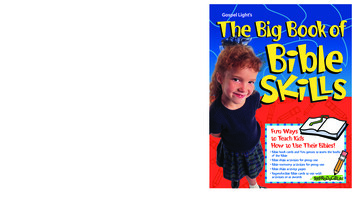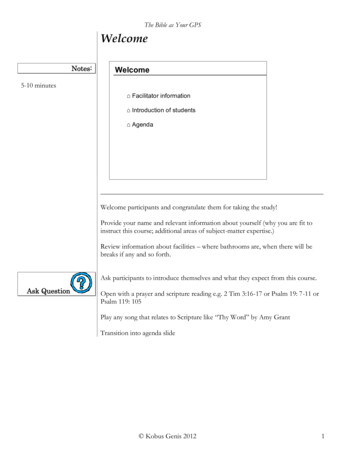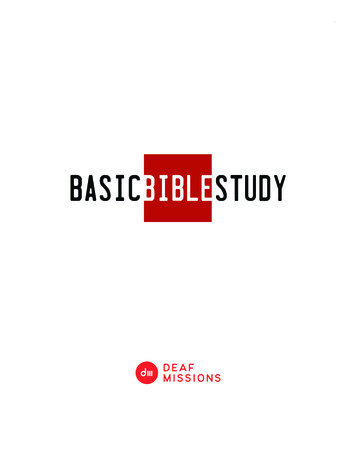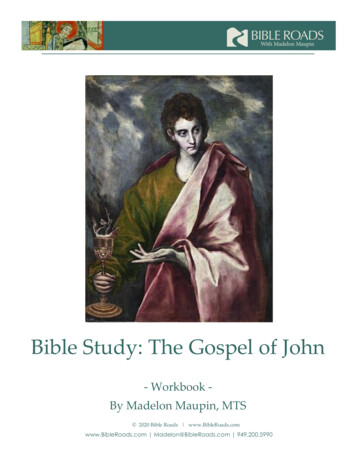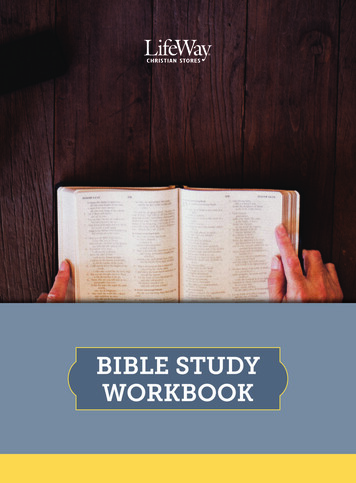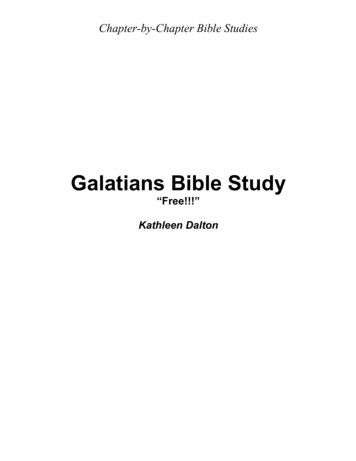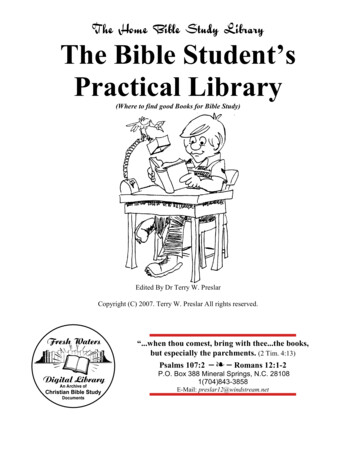
Transcription
The Home Bible Study LibraryThe Bible Student’sPractical Library(Where to find good Books for Bible Study)Edited By Dr Terry W. PreslarCopyright (C) 2007. Terry W. Preslar All rights reserved.“.when thou comest, bring with thee.the books,but especially the parchments. (2 Tim. 4:13)Psalms 107:2 S É S Romans 12:1-2P.O. Box 388 Mineral Springs, N.C. 281081(704)843-3858E-Mail: preslar12@windstream.net
The Home Bible Study LibraryThe Bible Student’s Practical Library(Where to find good Books for Bible Study)There is a need that the student have resources to learn the elements needed. To provide this need I offerthis article to described material that will supplement the Study Notes. It is expected that the student willhave personal study material that could including following recommended books are. This is not anextensive list of available books. These volumes are just some good books found on my personal libraryshelves. A small library for Bible study will net big gains in the work of the Gospel.The use of books is a constant occupation for “most” pastors and preachers and Bible students. The manwho thinks he can get by without doing this type of work is bound to exhaust his personal resources in shortorder and, with no way to replenish his reserves becomes, the proverbial “broken record” of repetitivesermons and illustrations. This lesson unit addresses the library problem and the solution. I have been buyingbooks in this field for (soon will be thirty-five years) many years and have made a few mistakes but with theLORD’S help I have kept this to a minimum. I hope to offer this advice in order that my readers may starta library right and set a pattern that can last for many years and produce a long and fruitful ministry for thecause of CHRIST.An interesting limited edition water color print hangs in my study that tells the basic story for a pastor’sstudy needs. Painted by Evangelist Ron Cockerham; it shows a pair of black “wing-tip” shoes, an openedpackage of “Halls cough drops”, an opened package of “Certs”, three books and a “GOD’S Simple Plan OfSalvation Tract.” The Three books are a basic Bible students library.First in the order of “must’s” is a well bound, with readable text, Bible to use in study and preaching (inthe picture it appears to be a black #179X, Oxford, “Old Scofield Reference Bible”). This Bible must beprinted on paper that can be marked to keep notes that need to be taken as you read. I see no need to use anyother version than the KJV and the use of other versions in your private study is not a good idea either (Idon’t care how wise you are, the Bible needs NO correction and you nor I are in any position to correct itat any rate -to attempt to correct the word of GOD can only make us all look like a bunch of jerks, we arecalled to preach not correct the WORD).Secondly, the basic Bible students library must include a good dictionary of the English language. Oneof the new ones that list all the new words will not do at all -we are going to study words from 1611 and thewords encountered in these pages are not new; so this piece needs not be a modern word list. I use“Webster’s Seventh New Collegiate Dictionary” from the second hand store (good hardback 1.00). The1828 Noah Webster’s “American Dictionary of the English Language” is back in print and can be orderedwhich would be excellent for this place in the library of the KJV student.The last volume in the basic Bible students library is the concordance. The water color print painted byBro. Ron shows a “Strong’s” (the old green Abingdon edition). I bought my “Strong’s” about 1970 or so(the blue Abingdon edition) for 15.75 and I thought it was the best buy I had ever made at the time. Todayyou can get reprints for below 10.00 and therefore are a “must” for the basic Bible students library. Bro.Ron’s painting could have been inspired by Lester Rolloff’s statement that “.all you needed to study theBible was your 1611, a good dictionary and Strong’s concordance.” These classically true words can beextended to cover the broad needs of Bible research when used with a little wisdom and thoughtful reflectionupon the subject. The print would be a great gift for some preacher.As the LORD allows in the next few pages I will address these areas of the basic library with a list ofoff the shelf selections for the reader’s use. Follow me through each of these investigations and have a booklist for the Basic Bible students Reference Library.-1-
Some Direction NeededAs I mentioned above, we are addressing the subject of the “Basic Bible Students Reference Library”and hopefully learn from this, the ways of Bible research. To gather the facts of Bible Truth and offer themin the pulpit is a blessed task – I have never studied for a sermon that did not bless me more than I could everimpart to the hearer in the pew. Sad but true (sad only in that I cannot get out all that HE gives me in mystudy), this is GOD way of rewarding me as a student of HIS Word.There is a need that the student have resources to learn the elements needed. To provide this need I offerthis paper to described material. It is expected that the student will have personal study material that couldinclude the following recommended books. This is not an extensive list of available books. These volumesare just some good books, most of which are found on my personal library shelves. A small library for Biblestudy will net big gains in the work of the Gospel.The Bible Student’s Core Reference LibraryThe “Core Reference Library” for Bible Study is the first thing, outside your personal Bible, neededto be effective in this great work. A “Study Bible” is helpful; but, the more you use your study Bible, themore you’ll feel the limitations of its built-in helps. That’s when you know you need to begin building your“Core Reference Library,” a set of five reference books that will give you an OVERVIEW of the Bible(Bible Handbook), help you FIND verses and passages in the Bible (Concordance and Topical Bible), helpyou UNDERSTAND things in the Bible (Bible Dictionary). This “basic” library will soon grow into as manyas 10 sections and we are off to the development of a Reference Library.1. A Bible Handbook is a companion to Bible reading. These books are really great. They containbackground, archaeology studies, histories, explanations, mini-commentaries, notes, outlines, mapsand all kinds of information you would otherwise have to pour through volumes and volumes ofbooks to get. This is the basic reference book. There are two pretty much standard works used byalmost everyone. Halley’s Bible Handbook, and Unger’s Survey of the Bible. There are many othersthat are quite good, but these two seem to me to be the most useful.It’s arranged in the order of the books of the Bible, and provides background before you readthrough a Bible book, commentary and illustrations as you read, and topical and historical notes toexpand your understanding.The first Bible Handbook ever published was Halley’s Bible Handbook. It was a revolutionaryconcept that came out of Dr. Halley’s desire to get people to read the Bible with more understanding.It remains a perennial bestseller to this day.How to Choose – A Bible handbook is arranged in the order of the books of the Bible, and typicallycontains maps, charts, indexes, essays on special topics, outlines of Bible books, briefcommentary on the Bible text, and cross-references to other parts of the Handbook. AskYourself: “Is it more devotional or informational?” “Which am I looking for?” “How much morecontent does it have than my Study Bible?” “Is it too basic for my needs?” “Do I plan to use itpermanently or temporarily?” (If you will be using it permanently, get the best you can afford.)“Is it well indexed? Are the illustrations and charts helpful and easy to use?” “Is it readable andusable?”Using the Bible Handbook – The Handbook is a primary reference book (after the Study Bible)because it is comprehensive and easy to use. To use a handbook, you simply open the Handbookto the book of the Bible you’re reading. All of the relevant information is right there. You don’tneed any advanced knowledge to use the Handbook. It’s an ideal basic companion to Biblereading, especially for people who are less familiar with the Bible.-2-
If you have a Study Bible and would like a reference that deals more with the meaning of thetext, the Bible Handbook includes a basic Bible commentary. Such a book is the Halley’s BibleHandbook.2. A Concordance – Now we get into reference books where you do the work instead of benefiting fromwork already done. It is important to get an exhaustive concordance. An exhaustive concordance willlist EVERY word in the Bible alphabetically. There are many uses for this. When you can’t find acertain passage, but you know a couple of the words, look it up in the concordance. When you doa word study of, say the word gold, you can find all the places where gold is mentioned. A Strong’sconcordance will also give you the Greek, Hebrew, and Aramaic definitions of all the words in theBible.There are three notable concordances for the KJV. The Strong’s Exhaustive Concordance (forthe strong) edited by James Strong, the Young’s Analytical Concordance (for the young) arrangedby Robert Young and the Cruden’s Exhaustive Concordance (my favorite) by Alexander Cruden.A Concordance lists common words found in the Bible and shows the places where they occur.For example, under the entry faith you would find the locations in the Bible where the word “faith”is used. A concordance enables you to do word studies as well as locate verses you vaguelyremember.How to Choose – Concordances come in different sizes, ranging from brief, abridged concordancesin the back of most Study Bibles to Exhaustive Concordances of almost 2,000 pages. There arefour basic types:Handy, concise, or compact concordances are in some way abridged. Only the most importantwords found in the Bible are included, and only the most important references for thosewords are listed. This type of concordance may be adequate if you only use this tooloccasionally to find a Bible verse. (These are found in the appendix of many editions of theBible).A complete concordance is still abridged, but in a different way. Not all words found in theBible are included, but the list of references for each of the words that is included iscomplete. If you want to do English word studies, a complete concordance is a must, thoughan exhaustive concordance is even better. (These are found in the appendix of better editionsof Study Bibles).An unabridged concordance indexes every word and lists every reference. (Cruden’s). In thecase of Cruden’s, it also offers, almost preachable, definitions for many of the importantwords.An exhaustive concordance indexes every word and lists every reference. It also shows whichHebrew or Greek word is translated for every occurrence of every English word in the Bibleversion. If you want to do in-depth word studies based on the occurrences of Greek andHebrew words, an Exhaustive Concordance is indispensable. The best-known ExhaustiveConcordance is Strong’s, which is based on the King James Version. The Young’sConcordance is an exhaustive concordance that uses a different method to present theinformation (Analytical).A very useful feature of exhaustive concordances is a numbering system which assignsa specific number to each of the Greek and Hebrew words found in the Bible. The Strong’sExhaustive Concordance uses a powerful numbering system, which reflects the Hebrew orGreek usage of the words in an easy to use way. The Strong’s numbering system is widelyused by many other reference works. There are also concordances that are based directly onthe Greek and Hebrew text. (The Englishman’s Hebrew and Greek Concordances are fineexamples of these)Ask Yourself: “Do I want to use it to find a verse or to do word studies?” “Is there anumbering system?” “Do I own a computer?” (Software can perform the same functions as-3-
a Concordance with greater speed and flexibility.)Using a Concordance – Read the introduction to your concordance so you know its features andlimitations. If you can’t locate a word, look for its dictionary form (for example, if you can’t findwent, look for go). Look up other inflected forms or roots of words. Many concordances directyou to the various inflected forms of words (e.g., come, comes, coming, came) or even to wordsof the same “root” (e.g., heart, faint-hearted, half-hearted). By looking up the other forms orspellings, you can do a more thorough word or concept study.When doing a word study, use an English thesaurus to find synonyms and related words. Forexample, under faith a thesaurus will list words such as belief, hope, confidence, assurance,dependence, trust, etc. Don’t study in the Concordance alone use your Bible. Always read thecontext in which a verse is found, not just the verse or piece of a verse. For example, Psalm 14:1says, “There is no God” but the context tells you what the fool says.When you do a word study, read the verses you find, in their context, in several translations.Very few words especially abstract words have only one, clear-cut meaning. An analyticalconcordance is somewhat similar to an exhaustive concordance but is arranged differently. Theonly analytical concordance available is Young’s Analytical Concordance (to the KJV).Also we must not forget the concordances for the original languages – Greek, Hebrew andAramaic. In these books instead of looking up a word in English and finding all the occurrencesof a word, we can look up the original Hebrew or Greek word and find all the occurrences! Sowhat if you don’t read Greek or Hebrew? No problem if you bought Strong’s ExhaustiveConcordance! You look up a word in Strong’s and get Strong’s word number (there is a numberfor every word in Strong’s) then, you take that number, and if you buy Baker’s Hebrew andGreek Concordances, look it up. The book will list all the places that exact word is used. Thereare two Concordances that are more useful than others: The Englishman’s Hebrew and ChaldeeConcordance of the Old Testament numerically coded to Strong’s Exhaustive Concordance byGeorge V. Wigram, and; The Englishman’s Greek Concordance of the New Testamentnumerically coded to Strong’s Exhaustive Concordance by George V. Wigram. Both arepublished by Baker Book House and are in print. Also many books of this kind are available inE-Book Format (PDF files are very useful – See the section “E-Books”).3. A Topical Bible includes a guide to different subjects addressed in the Bible. Under faith, it will listnot only the most important verses where the word “faith” is found, but also verses that talk aboutfaith without using the word, for example Genesis 15:6, “Abram believed the LORD .”How to Choose – You can use a topical Bible with any translation of the Bible, even if it quotesfrom a particular translation. Some topical Bibles list only biblical and theological topics, whileothers focus more on practical topics. Make sure you choose the kind you want. The size of atopical Bible doesn’t necessarily reflect the number of topics or references it contains. A smallone that gives only verse references may actually be more complete than a big one that prints outthe full text of many verses.Since a concordance and a topical Bible complement each other, I recommend that you usethem together, rather than choosing one over the other.Ask Yourself: “Which one best addresses the subjects I want to study?” “How muchinformation does each topical Bible contain?” “Does the editor’s choice of topics and theirrelative length seem balanced?” “Are the topics well subdivided and indexed?” “Are the Bibleverses printed out in full?” “How important is this feature to me?” “When was it originallypublished and last revised?” “Which one seems most user-friendly to me?”Using a Topical Bible – If you want to study a topic such as baptism, a concordance will only giveyou a list of all the verses in which the word baptism occurs. A topical Bible, on the other hand,will help you also find verses and passages in the Bible that talk about the subject of baptismwithout using the word baptism as such.-4-
4. A Bible Dictionary (or Encyclopedia) gives more detailed information about people, places, words,and events in the Bible. You could use it to learn more about what the Bible says about children, orabout Peter, or Egypt, or miracles.A Bible Dictionary or Encyclopedia lists just about any concept or topic in the Bible and seeksto explain it, or give background on it. You might look up chariots and find out all kinds of thingsabout a chariot. You might look up Paul and get a brief biography of him. These books are not justparallel passage works (although they contain that as well), but also contain archaeologic and historicinformation not found in the Bible.A Bible Dictionary is more like an encyclopedia than like a regular English dictionary. It givesdefinitions and pronunciations, but it also provides biblical, historical, and theological informationon people, places, words, and events in the Bible, all in alphabetical order. (A Bible encyclopediais simply a multi-volume Bible dictionary.)Bible dictionaries and encyclopedias, such as “Easton’s Illustrated Bible Dictionary” or “Smith’sBible Dictionary,” don’t define every word of the Bible. They focus mostly on nouns people, places,and things although some also have articles on theological terms that are not in the Bible, such asTrinity. (Some Bible Dictionaries are more specialized, such as Hichcock’s Dictionary of BibleProper Names or “Wilson’s Dictionary of Bible Types”.)You could spend many a fulfilling evening browsing through one of these books. Some namesto look into are Unger’s Bible Dictionary, Smith’s Bible Dictionary, New Bible Dictionary, DavisBible Dictionary, Harper’s Bible Dictionary, Easton’s Bibl Dictionary, The International BibleEncyclopedia and many others. Unger’s Bible Dictionary is also available in a generic soft-coverwhen you can find it. Also many books of this kind are available in E-Book Format (PDF files arevery useful – See E-Books).Another dictionary that is very useful is the Expository Dictionary. An expository dictionarydiffers from a Bible Dictionary in that we actually look up a word used in the Bible and get acomplete definition of that word as used in the text, as opposed to a general definition as you findin a concordance. Here, the standard work is Vine’s Expository Dictionary. Available in a singlevolume, the price is quite modest. Also, there is Wilson’s Dictionary of Old Testament Words, andothers. Often, these works are not exhaustive, but will contain just about any word you’d like to lookup.How to Choose – It can be helpful to have more than one Bible dictionary, especially if they’resomewhat different in focus or orientation. Look for thorough cross-referencing. If you don’tknow the exact word to look up, a good cross-reference system will anticipate many of yourguesses and help direct you to the topic you’re looking for.Ask Yourself: “What kind of information will I most likely want to look up?” “How manyarticles does the dictionary have?” “Do I prefer many shorter articles, or fewer but longer ones?”“Does it have good cross-references?” “What size dictionary is best for me?” “What type sizeand page layout do I like?” “Do I want a dictionary that uses more every day English or a morescholarly one?” “When was this dictionary originally published and last revised?” (Historical,archaeological, and linguistic knowledge has grown dramatically over the past decades.)Using a Bible Dictionary – Cross-references or cross-indexing can help you find articles of relatedinterest. An article about Jesus might end with “See also ATONEMENT, MESSIAH,MIRACLES, PARABLES, SECOND COMING,” to name just a few.A good English dictionary is an indispensable tool for use with your Bible dictionary. Theremay be unfamiliar words in the Bible that you won’t find in a Bible dictionary. Your Bibledictionary probably won’t help you here, but your English dictionary will. The Webster’s 1828is said to be the dictionary that addresses the words used in the KJV. Webster’s 1828 Dictionaryis still in print and there is also a computer edition of this very fine reference work.An English thesaurus is another valuable tool. For example, if you can’t find an article on-5-
“Gentiles” in your Bible dictionary, a thesaurus may suggest “heathen”as a synonym, and thatmay be the right heading in the Bible dictionary.5. A Bible Commentary is a single or multi-volume work that explains the meaning of Bible passages.Commentaries give the commentator’s perspective on passages in the Bible. They should never bethe first books you check when doing a Bible study if you do, you start with somebody else’sconclusions rather than finding your own. There is no substitute for first-hand study, using the toolsof the Core Reference Library and relying on the illuminating presence of the Holy Spirit. On theother hand, commentaries can be helpful in supplementing your own study by giving you otherperspectives and additional insights.A Commentary seeks to explain the scriptures to us. The focus each commentary ranges fromdevotional to expository, from practical to prophetic, from surface level to in-depth, from completesets to individual books, from one-volume commentaries to 20, 30 and 40 volume sets. Everyoneshould probably have a one-volume commentary, at least most people think so! The classical,standard one to have is Matthew Henry’s one-volume commentary, but deserving of mention is theWycliffe One Volume Commentary. These are pretty much basic, devotional commentaries that willhelp with insights that you can use every day.But you don’t just buy a one-volume commentary thinking that you’ll never buy another one! Aone-volume commentary is of very limited use. More useful is to buy a commentary on a book youare studying. For this, you’ll have to become familiar with authors until you find your favorites. Iprobably have five or six commentaries on the book of Revelation alone, not to mention at least thatmany sets of commentary tapes on the book of Revelation! The best I can do to stretch yourcommentary dollar is to list a few authors I like. To name just a few out of literally hundreds, I’d sayRay Stedman, Arthur W. Pink, Donald Barnhouse, G. Campbell Morgan, M.R. DeHaan, and JohnWalvoord. But don’t go out and buy a million commentaries right away. Just pick up a one-volumecommentary, and gradually acquire a collection as need arises. (I buy commentaries now if I findthem).How to Choose – Choosing a Commentary, perhaps more than choosing other Bible referencebooks, is a personal matter. The key issue is which commentary answers the kinds of questionsyou are likely to ask. As usual, you should take time to look at what’s available. Compare beforeyou buy. One consideration for comparison is what theological perspective the author is writingfrom. Another consideration is the date of publication-some historical and cultural informationin older Commentaries might be outdated or incorrect, but the devotional material in them wouldbe timeless. Commentaries come in many different sizes. You can get a Commentary or set onthe whole Bible or for individual books of the Bible.Using a Commentary – Devotional Commentaries, such as Matthew Henry’s Commentary, focuson the spiritual significance of the text for our lives. Expository Commentaries focus onexplaining the text.– Most expository Commentaries, such as the Expositor’s Bible Commentary, use historical,geographical, and cultural information as well as discussions of the original languages toexplain the text.– Others, (example) concentrate on bridging the cultural gap between Bible times and today.– Exegetical or Critical Commentaries focus primarily on technical issues related to the Greekor Hebrew text and its interpretation and are written primarily for specialists. (Example: TheInternational Critical Commentary)Ask Yourself: “Is the Bible text included?” “Is there an explanation of the text?” “Ishistorical, geographical, and cultural information included?” “Are there word studies andgrammatical explanations?” “Are there critical notes dealing with historical and contextualinterpretations?” “Are footnotes, bibliography, and indexes included?”-6-
6- Manners and Customs Books – These books give insight into the backgrounds of the culture andpractices of Bible times. There is no real set standard here, but a valuable feature in one of thesebooks is that it is keyed to the Bible reference rather than by topic. (“Manners and Customs of theBible” by James M. Freeman).7- Lexicons – Now that we can look up all the occurrences of the original words, we can get even morecomplete definitions of words from a Lexicon! Again, coded to Strong’s Exhaustive Concordance,there are “Gesenius’ Hebrew-Chaldee Lexicon to The Old Testament” - a dictionary numericallycoded to Strong’s Exhaustive Concordance with an exhaustive English index, and “Thayer’s GreekEnglish Lexicon of the New Testament” - a dictionary numerically coded to Strong’s ExhaustiveConcordance. Again, these two books are inexpensive (in soft-back from Baker), and match the twoconcordances previously mentioned (“Englishman’s Hebrew/Chaldee and GreekConcordances”).There are lots of others, but the advantage to these is that, because of the Strong’sNumbring, you don’t need to read Greek or Hebrew.8- Atlas of the Bible – There are a number of books in this category. “Baker’s Bible Atlas,” “Nelson’sBible Atlas,” “Hammond’s Atlas of the Bible Lands.” (Inexpensive atlas with splendid maps). EvenThe Gazetteer in the back of a good study Bible.9- E-Books and Computer Programs – E-Books, or electronic books are exactly the same as atraditional books, except there is no paper, thus saving production costs and offering widedistribution over the World Wide Web. The production cost savings are passed on to the customer,meaning that the price of an e-book is very low as compared to a traditional printed book and canbe distributed on a Web Site for download. Many the books distributed through this technology arein the Public Domain, used by the permission of the copyright.How Do I Read an E-Book? – E-Books can be read on your computer or laptop and certain typesof electronic organizers (Palm and Pocket PC both have Acrobat Reader software for freedownload). To read E-Books, you simply use the web browser in your PC, Laptop or Mac byusing the windows help file reader that comes with windows, the freeware “Adobe AcrobatReader” or in the case of “HTML” files (The Internet’s native format) your Browser can readmany of them. You do not have to be on line to read your E-Books. This (HTML) is the universalformat supported by all web browsers. If you have an organizer or reader with the WindowsMobil (or CE) operating system, you can load HTML formatted books for reading. With thiskind of book, you can use a laptop or notebook computer, then you can curl up on your favoritechair or relax in bed, whilst studying and reading your favorite Bible Study Commentary orChristian Classic. Alternatively, you can print out the book for reading on paper. Using yournormal Windows PC or Laptop it is easy through the “Windows Help” format if it has a webbrowser installed, simply follow the instructions which come with our books. Venders supplytitles in “HTML”, “Windows Help” and “PDF” formats. Many Special Edition books are inAdobe Acrobat Format (PDF).It resent times many of these files are published as Adobe Acrobat (.PDF) files and can beviewed with the free Acrobat Reader that can be downloaded free from that web site, installedand used freely. tml)10- Authors of Bible Study Works – Now, I’d like to take some time to list a few of the authors thatwhenever I see their books, I buy them on sight because their insights into the Scripture are just thatvaluable.Donald Gray Barnhouse – Dr. Barnhouse has written commentaries on Romans, Genesis, andRevelation. He is quite readable and probably one of the best devotional authors.Arthur W. Pink – My favorite author, this guy gets more out of a single verse in the Bible, than mostpeople get out of the whole chapter. He isn’t as readable as a lot of other writers, but he packsmore information into a book than anyone else.-7-
M.R. DeHaan – Another one like Pink, but DeHaan also keeps the big picture in view. He’s moreapt to look at things chapter by chapter. A bit easier to read than Pink, DeHaan was also a doctor.G. Campbell Morgan – His books are transcribed from his sermons (like many other authors). He,like Pink and DeHaan examines things using typology when applicable. He has a great set ofcommentaries out on the gospels, and another great book on the “Parables and Metaphors ofOur Lord.”John R. Rice – Called “The 20th Century’s Mightiest Pen,” Dr. Rice authored more than 200 booksand booklets circulating in excess of 60 million copies before his death, about a dozen of whichwere translated into at least 35 foreign languages.Herbert Lockyer – This remarkable writer has contributed a body of work that is very useful. His“All.” Series is worth collecting. His “Last Word of Saints and Sinners” gives manyillustrations and most of his will be worth having.Oliver B. Greene – Dr. Greene was called Home to be with the Lord on July 26, 1976, but he “beingdead, yet speaketh,” not only by radio but by his writings. His books, pamphlets, tracts, totalingabove 100 titles, are still mailed out by the thousands.Harry Ironside – Authored more than 60 volumes as well as many pamphlets and articles on Biblesubjects. For all his critics (many say his writing is simple), most preachers end up with manyof his books on their shelves.Ray Stedman – Ray Stedman is a teacher in cent
Bible was your 1611, a good dictionary and Strong’s concordance.” These classically true words can be extended to cover the broad needs of Bible resea rch when used with a li ttle wisdom and thoughtful ref lection upon the su






